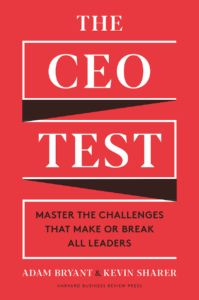The CEO Test
In their new book, The CEO Test: Master the Challenges that Make or Break All Leaders Adam Bryant, who has interviewed more than 600 leaders across his career in journalism and consulting, and Kevin Sharer, the former CEO of biotech giant Amgen, identify the seven key tests that determine whether leaders at all levels will succeed in their roles. Drawing on the insights, stories, and strategies that they have learned over the years, they also provide an intensely practical playbook for navigating those challenges. We asked them to share some of their key insights from the book.
From the title of your book, what are some common challenges that all leaders face?
My co-author, Kevin Sharer (the former CEO of Amgen), and I set out to answer two key questions – what are the main reasons why leaders succeed or fail in their roles, and what is the playbook for navigating those core challenges? After a very long process of winnowing, we identified seven key tests:
- Can you develop a simple plan for your strategy?
- Can you make the culture real—and matter?
- Can you build teams that are true teams?
- Can you lead transformation?
- Can you really listen?
- Can you handle a crisis?
- Can you master the inner game of leadership?
A key point of distinction is that the first six chapters are about what leaders must do, while the last chapter, about the inner game of leadership, is focused more on how leaders must be.
What are some reasons that leadership is getting more challenging?
The pandemic has presented an enormous challenge for all leaders. How do you lead virtual teams? How do you show more compassion and humanity, while maintaining a culture of accountability? How do you strike a balance between optimism and realism, given the profound business challenges of the past year? How do you lead when the wall between the personal and the professional lives of workers has fallen? How do you lead in the fog, given that long-term planning is no longer possible amid all the uncertainty?
The pandemic has presented an enormous challenge for all leaders.
If that weren’t challenging enough, now add on the layers of new responsibilities that leaders face as companies contend with more of the challenges facing society at large. A couple of decades ago, CEOs had to worry mostly about vocal institutional shareholders; today, there is a growing list of stakeholders, including employees, who feel like they have a voice and vote in the company’s policies.
Let’s talk about test number one: Can you develop a simple plan for your strategy? You say that “Simplifying complexity is a leader’s superpower.” Why is it so rare? What observations can you share from your work in this area?
There are a few reasons why this skill is so rare. For one, companies and leaders often have different ideas of what strategy means, and strategy is the key manifestation of this skill of simplifying complexity.
Some companies describe their strategy in very high level and general terms, so that the strategy is more about what the company does than about what it is trying to achieve and how it is going to win against its competitors. At the other extreme, companies can dive down into the weeds and focus on short-term initiatives as their strategy. What’s missing is a simple plan that describes what the company is trying to achieve, the three or four key levers it needs to pull to reach those goals, the main challenges it faces, and a scoreboard for measuring progress and success.
We often find that the strategy is much clearer in the CEO’s mind than it is to everyone else.
Another challenge is what I call “expert-itis.” This occurs when a leader becomes so steeped in the nuances and intricacies of their business that it becomes hard to step back and remember what it’s like to see the company strategy through the eyes of a frontline employee. In our consulting work, we often find that the strategy is much clearer in the CEO’s mind than it is to everyone else.
And so it takes conscious effort and discipline to always be trying to simplify (but not oversimplify) the messaging so that employees can understand, in broad brush, how their work is helping drive the strategy and why it’s important.
How do the best leaders think about, and build, a strong company culture?
It takes sustained, intentional effort to build a strong culture. That starts with gaining clarity around the values that the company will adopt, and then being explicit about the behaviors that are expected of employees and what will not be tolerated.
The leaders then have to make sure those values are brought to life at key touchpoints of the employee experience, including hiring, onboarding, all-hands meetings, quarterly and annual awards, and the stories that the leadership team tells. The test of those values is the proverbial high-performing jerk – will that person be tolerated, even if their behaviors directly contradict the stated values? If they are, then employees will see the gap between what leaders say and what they do, and that will breed cynicism in the organization.
Teambuilding is a crucial element of leadership success. What are some tips you’ve learned about building a winning team?
Like culture, building high-performing teams is an intentional act. Otherwise, they will default to an all-too-common dynamic of people getting together without a clear agenda, and members of the team playing politics to fight for resources and attention.
We believe that every leader has to answer four key questions about their team: Why are we a team? Who should be on the team? How will the team work together? What is the leader’s role on the team?
The answer to “why are we a team?” may seem self-evident, but it’s not.
The first two are worth expanding upon here. The answer to “Why are we a team?” may seem self-evident, but it’s not. And there is really only one right answer to that question, which is to tackle challenges that only the team can address together. Teams exist to address those big priorities that companies face that require cross-functional collaboration.
And the second point is crucial, as well. Who should be on the team? In our consulting and mentoring work with leaders, we often find that they will talk about the members of their teams in terms of their loyalty, their commitment, and the fact that they have been with the company a long time. We then remind those leaders that their team members have to be viewed through the lens of performance, and whether they truly have the skills to drive their part of the strategy. There is simply no substitute for having a good team.
What tips can you share about becoming a better listener?
In the book, we talk about listening in two contexts. The first is in 1:1 and small group meetings. In those settings, leaders have to ensure that they are setting a tone that they are listening for comprehension — that they have an open mind, are not distracted, and are eager to hear and understand what people think to better inform their point of view on an issue. It means listening without judgment or agendas, and learning to keep quiet.
The higher they move up, the more leaders become trapped in bubbles.
The second context is about listening to the organization more broadly. The higher they move up, the more leaders become trapped in bubbles, with people not wanting to share problems or concerns with them. Information is massaged or tamped down, and PowerPoint decks are polished to a bright shine to show that “everything is going great, boss.”
The best leaders are aware of this phenomenon and take active measures to counteract it by creating a kind of listening ecosystem and infrastructure to make sure they have a direct line to the unvarnished thinking of all workers. My co-author, Kevin Sharer, added a question to the annual employee survey when he was running Amgen – “What do you think of the job that Kevin is doing?” That included an open field on the survey with which employees could tell him what they thought.
When you see someone and immediately think “this leader is not going to make it” what are the primary reasons?
The most obvious and immediate signs are an inability to concisely describe the strategy or have an ambitious plan for growing the organization or their particular unit or division. Ron Williams, the former CEO of Aetna, memorably described this as someone’s “forward radar,” and you can tell pretty quickly if someone has it or not. Do they see the possibilities for the business, and are they able to articulate a plan to realize them?
The second one is whether somebody listens. If they seem convinced that they have all the answers and don’t need input from anyone else, then they are going to suffer from all the blind spots that they have created for themselves. Decades ago, that command-and-control approach to leadership may have worked for some, but there is just too much disruption going on in every industry now, and leaders need to hear different perspectives on both opportunities and challenges if they are going to survive and thrive.
What surprised you most in researching and writing this book about leadership?
 The biggest unknown for Kevin and me was whether we could deliver on the goal we set for ourselves — to simplify the sprawling and complex field of leadership down to a manageable number of “tests.” But we ultimately were able to land on the seven tests that we discuss in the book, and that concise approach seems to be resonating well with readers of the book.
The biggest unknown for Kevin and me was whether we could deliver on the goal we set for ourselves — to simplify the sprawling and complex field of leadership down to a manageable number of “tests.” But we ultimately were able to land on the seven tests that we discuss in the book, and that concise approach seems to be resonating well with readers of the book.
The pandemic started while we were writing the book, and we kept asking ourselves whether these tests were just as relevant in the crisis as they were before the pandemic. We believe they are. The companies that had a clear strategy, an intentional culture, strong teams and the willingness and skills to see the crisis as an opportunity are emerging stronger for it.
For more information, see The CEO Test: Master the Challenges that Make or Break All Leaders.
Image Credit: Danka and Peter

